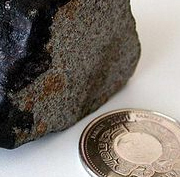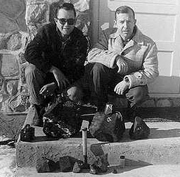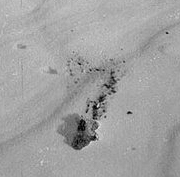Official Name:
The Bruderheim meteorite shower came raining down ten kilometres north of the city of the same name.
Location:
100 kilometres northeast of Edmonton, Alberta, Canada.
Fall or Find:
Fall
Date:
March 4, 1960 at 1:06 a.m., local time.
Mass Recovered:
The total weight of the recovered fragments is 303 kilograms. This is the largest meteorite that has fallen in Canada to date.
Number of Fragments:
Close to 700 fragments were collected. Individual fragments of Bruderheim weigh from 5 milligrams to 30.7 kilograms.
Strewn field:
On the ground, the rocks covered a surface area of 5.6 by 3.6 kilometres. The fragments were not really spread out according to their mass, which in theory should be the case. Large fragments were found among the smaller ones and vice versa. The meteoroid broke apart at high altitude and as the fragments fell, they were buffeted by the wind, which affected how they were distributed on the ground. Large masses did not survive the shock. They broke up into smaller pieces when they hit the ground.

Enlargement
Fragment of the Bruderheim meteorite with its shiny black fusion crust and a view of its internal composition. |
|
|
Crater:
A few depressions were created by the largest fragments from this shower. They burrowed down about twenty centimetres into the frozen ground. One fragment had a softer landing-its fall was cushioned by a stack of wheat.
The small fragments passed through the layer of snow, bounced off the frozen ground, and returned to the surface spewing up a bit of dirt with them. This phenomenon made it easy to locate meteorites since they were surrounded by ejecta that contrasted with the immaculate snow.
Circumstances:
Despite the late hour, many witnesses observed the fireball. It crossed the sky from west-northwest to east-southeast. The explosion of the meteoroid lit up the sky over Edmonton. A sonic boom followed, reverberating over a radius of more than 100 kilometres. After the high-altitude fragmentation, the rocks continued to glow. The luminous phenomenon changed from white to red as the fragments approached the ground. Slowed by their passage through the atmosphere, the rocks ended their journey being pulled down by the force of gravity alone.

Enlargement
Tyrone Balacko and Stan Walker with a few of the meteorites they discovered. |
|

Enlargement
A fragment close to its impact site marked by a spattering of mud. |
|
A farmer named Nick Broda found the first suspicious black rock in front of his home. Stanley Walker, an amateur astronomer, gathered eyewitness accounts and set about the systematic search for fragments. Aided by a mineralogy enthusiast, Tyrone Balacko, he collected approximately 75 kilograms of meteorite material in one weekend. The two men recorded their discoveries and drew up a map of the strewn field.
History:
Once the snow melted, teams of scientists from the University of Edmonton combed the strewn field without success. They quickly acknowledged that local farmers would be much better at finding fragments of the meteorite. Time proved them right-most of the specimens in the university's collection were purchased from the citizens of Bruderheim.
Type:
Stony meteorite
Class:
Ordinary chondrite
Group:
L6
Composition:
Bruderheim is covered by a thin fusion crust (0.25 millimetre). The meteorite is mainly composed of olivine and hypersthene. These minerals make up 41.7% and 25.9% of its volume, respectively. The chondrite has a low iron content, with the metal making up only 9.94% of its volume. Its chondrules were almost completely destroyed when the parent-body heated and then recrystallized.
Scientific contribution:
Scientists analyzed the gases captured inside the Bruderheim chondrite, the first meteorite to undergo this type of analysis. They discovered that the meteorite had lost 95% of its argon 550 million years ago. Analysis of other L-type chondrites has also confirmed a major loss of this gas between 400 and 500 million years ago. One of the parent-bodies-if not the only parent-body-from which L-chondrites originated may possibly have fragmented at this time.
Part of the Planétarium's collection:
Yes